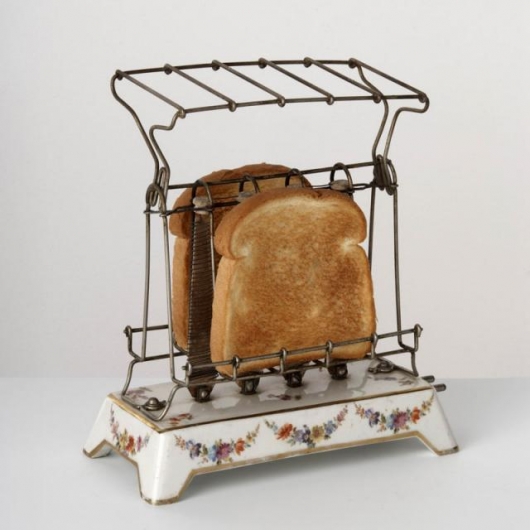
1905 Electric Toaster had open design with heating coils in the middle. Toast had to be turned by hand to brown both sides. It would cost $150 in today’s dollars.
Electricity is something most of us don’t spend a lot of time thinking about, unless your power goes out. Why am I writing about electricity?
Appliances.
While waiting for my toast to pop up this morning, I was absently thinking of appliances. WOW, imagine a time when there were no appliances?
How did Thomas Edison’s 1879 invention of a reliable, long-lasting electric light bulb bring electricity and the invention of appliances into homes?
Small electrical stations based on Edison’s designs were in a number of US cities by the end of the 1880s but most Americans still lit their homes with gas light and candles for another fifty years.
By 1930, the majority of people living in larger towns and cities had electricity but only 10 percent of Americans who lived on farms and in rural areas had electric power.
To bring electricity into households, Edison thought of a system that used the home’s existing piping as its framework. But, with this system, there was no convenient way of tapping into the power for anything other than light.
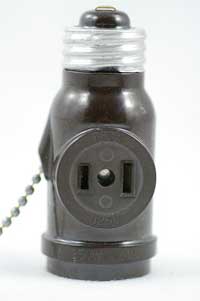
Light Socket Adapter
Harvey Hubbell designed a “Separable Attachment Plug” that was wired to an appliance and homeowners didn’t have to deal with connecting live wires from the home to the appliance. He later improved his design by making it with one portion that could be left in the socket and the other was a two-prong plug that was attached to the appliance and could be separated from the socket plug.
His plug also let you “leave the lights on” while using your appliance. Light-socket connections for appliances persisted into the 1920s. I remember seeing these sockets in the ceiling light sockets in the basement of my grandparent’s house.
An article by James Ryan published in October 1929 included an itemized list of the 7 to 11 electric appliances commonly found in homes. These were: washing machines; vacuum cleaners; refrigerators; flat irons; toasters; curling irons; percolators; heating pads; corn poppers; vibrators; and manglers (used to iron sheets)
The grounded plug, the one with two vertical blades and a round grounding pin, was a “necessity is the mother of invention” idea. It is told that engineering student, Philip F. Labre, landlady’s cat would knock over her fan when it came in her window. When she plugged the fan back in, she would get an electric shock. Labre figured out that if the plug were grounded, the electricity would go to earth through the plug rather than through his landlady. He was issued a US patent for grounding receptacle and plug in June 1928.
One 1928 ad featured a fashionably dressed woman leaving to play golf during the day because, as the caption insists, she was ‘no longer tied down by housework’ since she ‘spring cleans with electricity’ which was readily available ‘at the flip of a switch.’
So, what were the first electric appliances?
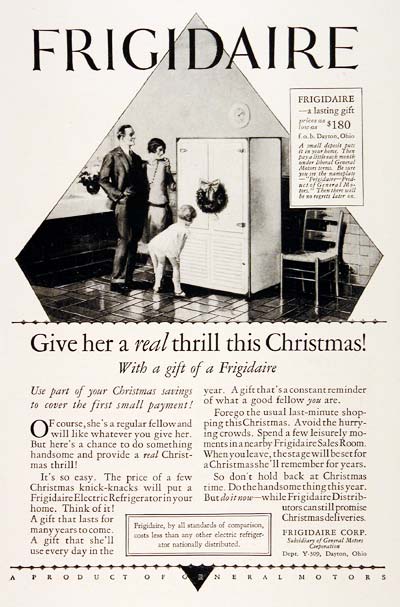
- 1800 – Electric battery invented by Alessandro Volta
- 1820 – First electric light demonstrated by Warren de la Rue
- 1821 – Electric motor invented by Michael Faraday
- 1821 – Electric doorbell invented by Joseph Henry
- 1854 – First light bulb invented by Hinrich Globel
- 1865 – Patent for electric coffee percolator issued to James Nason
- 1875 – Light bulb patented by Woodward & Evans
- 1879 – First practical incandescent light bulb demonstrated by Thomas Edison
- 1880 – First electric elevator constructed
- 1881 – First commercially successful dry cell battery invented by Carl Gassner
- 1882 – Electric Christmas lights introduced by Edward Johnson
- 1821 – Electric iron patented by Henry Seely
- 1885 – Electric mixer patented by Rufus Eastman
- 1886 – Electric dishwasher invented by Josephine Cochrane
- 1821 – Electric fan invented by Schuyler Wheeler
- 1889 – Home electric sewing machine introduced by Singer
- 1890 – First electric hair dryer patented by Alexandre Godefoy
- 1891 – Electric stove invented by Carpenter Electric Heating Co.
- 1821 – Alternating current (AC) introduced in U. S.
- 1893 – Electric toaster invented
- 1896 – Electric stove first patented (not for home use)
- 1898 – Battery-powered flashlight invented
- 1899 – Rechargeable battery invented by Waldmar Jungner
- 1900 – Electric toy trains invented by Joshua Lionel Cowen
- 1901 – Alkaline battery invented by Thomas Edison
- 1901 – Electric vacuum cleaner invented by Hubert Booth
- 1902 – First electric air conditioner in operation in Brooklyn
- 1903 – First electric washing machines patented
- 1901 – Lightweight electric iron introduced by Earl Richardson
- 1901 – Flashlight patented by Conrad Hubert
- 1905 – First moveable vacuum cleaner invented; weighs 92 pounds; doesn’t sell well
- 1906 – Permanent wave machine invented by Karl Nessler
- 1907 – Electric amplifier invented by Lee De Forest
- 1901 – Lightweight portable upright electric vacuum cleaner invented
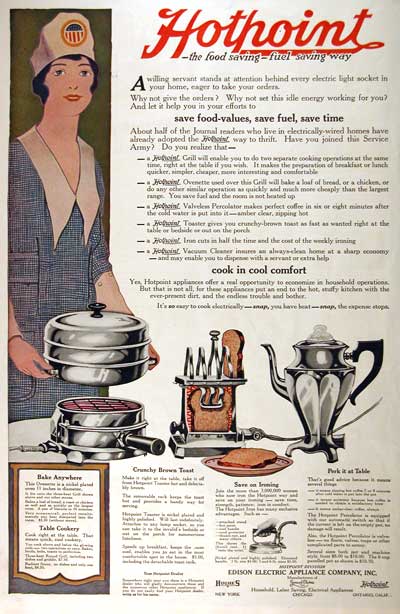
1919 Hotpoint Ad for Appliances states “A willing servent stands at attention behind every electric light socket… Why not set this idle energy to working for you.”
- 1901 – by James Spangler
- 1908 – Electric coffee percolators first appear in American stores
- 1901 – Spangler’s electric vacuum cleaner patented by William Henry Hoover
- 1901 – First electric-powered washing machine, the “Thor,” introduced by Alva Fisher
- 1901 – Standing mixer patented by Herbert Johnson
- 1909 – First American-made electric toaster introduced
- 1910 – Hotpoint introduces the first electric stove
- 1911 – Single-beater electric mixer patented by Hamilton Beach
- 1910 – Waffle iron introduced by General Electric
- 1910 – Neon lights invented
- 1913 – Electric dishwasher introduced by Walker Brothers
- 1910 – Bissell introduces 33-pound Electric Suction Cleaner
- 1910 – First in-home electric refrigerator introduced by General Electric
- 1915 – Electric clothes dryers appear on the market
- 1910 – Oven thermostat developed
- 1910 – Nine-pound vacuum cleaner introduced by Franz
- 1916 – Kelvinator introduces its first electric refrigerator
- 1910 – First electric lawn mower introduced
- 1910 – First radios with tuners allowed listeners to change stations
- 1918 – First refrigerator with automatic controls introduced by Kelvinator
- 1919 – Pop-up toaster with built-in timer invented by Charles Strite
- 1910 – Stand mixer for the home introduced by KitchenAid
- 1910 – Cone-shaped Christmas lights introduced by General Electric
- 1920 – More than 200 different brands of refrigerators sold in U.S.
- 1931 – Airway introduces vacuum cleaner with disposable bags
- 1931 – First commercial radio broadcasts with regularly scheduled programming heard
- 1922 – Electric blender invented by Stephen Poplawski
- 1931 – Electric kettle introduced
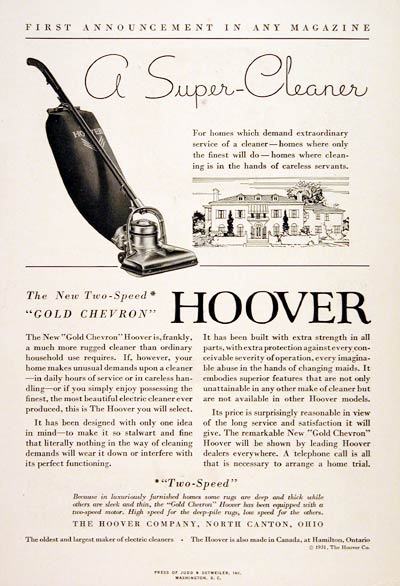
1931 Hoover Vacuum Ad “For homes which demand extraordinary service of a cleaner – homes where only the finest will do – homes where cleaning is in the hands of careless servants.”
- 1931 – Over 3 million electric irons have been sold since 1912
- 1931 – Radios appear in 3 million American households
- 1923 – Frigidaire introduces electric “self-contained” refrigerator
- 1931 – Cathode ray tube for television invented by Vladimir Kosma Zworykin
- 1924 – Air conditioners first used for human comfort rather than industrial cooling
- 1931 – Loudspeaker for music invented by Kellogg & Rice
- 1931 – Spin dryer appears on the market
- 1925 – Frosted light bulbs first produced
- 1926 – Toastmaster’s pop-up toaster invented in 1919 finally goes into production
- 1927 – Electric in-sink garbage disposal introduced
- 1931 – Electric iron with temperature control introduced by Silex
- 1931 – Quartz-powered clock developed by Warren Marrison
- 1931 – Experimental fluorescent lamp patented
- 1931 – Monitor Top refrigerator introduced by General Electric
- 1931 – GE introduces first in-home television receiver
- 1928 – First air conditioners for home use introduced by Carrier
- 1931 – Electric “Mixmaster” patented by Sunbeam Corporation
- 1931 – Improved electric permanent wave machine patented by Marjorie Joyner
- 1931 – Over 45% of American homes have a radio
- 1929 – Electric shaver introduced by Jacob Schick
- 1930 – First plastic vacuum cleaners introduced
- 1931 – First television broadcasts made in U. S.
- 1931 – GE introduces first room air conditioning unit
- 1931 – 1.2 million toasters sold in America
- 1931 – Henry Ford presented with one millionth GE Monitor Top refrigerator
- 1931 – Electric can opener introduced
All this from waiting for my toast to pop up! What do you think was the best use of electricity?




